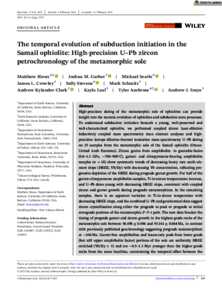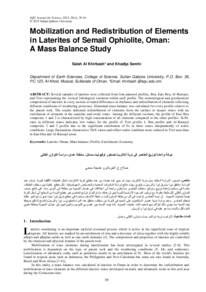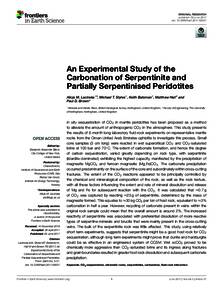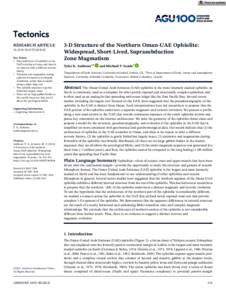وثيقة
The temporal evolution of subduction initiation in the Samail ophiolite : high-precision U–Pb zircon petrochronology of the metamorphic sole.
المعرف
DOI: 10.1111/jmg.12719
المصدر
Journal of Metamorphic Geology. v. 41, 6, p. 817-847
المساهمون
Garber, Joshua M., مؤلف
Searle, Michael., مؤلف
Crowley, James L., مؤلف
Stevens, Sally., مؤلف
Schmitz, Mark., مؤلف
Kylander-Clark, Andrew., مؤلف
Leal, Kayla., مؤلف
Ambrose, Tyler., مؤلف
Smye, Andrew J., مؤلف
الدولة
United States.
مكان النشر
Hoboken
الناشر
John Wiley and Sons Inc.
ميلادي
2023-08-01
اللغة
الأنجليزية
الملخص الإنجليزي
High-precision dating of the metamorphic sole of ophiolites can provide insight into the tectonic evolution of ophiolites and subduction zone processes. To understand subduction initiation beneath a young, well-preserved and well-characterized ophiolite, we performed coupled zircon laser-ablation inductively coupled mass spectrometry trace element analyses and high-precision isotope dilution-thermal ionization mass spectrometry U–Pb dating on 25 samples from the metamorphic sole of the Samail ophiolite (Oman-United Arab Emirates). Zircon grains from amphibolite- to granulite-facies (0.8–1.3 GPa, ~700–900°C), garnet- and clinopyroxene-bearing amphibolite samples (n = 18) show systematic trends of decreasing heavy rare earth element slope (HREE; Yb/Dy) with decreasing Yb concentration, reflecting progressive depletion of the HREE during prograde garnet growth. For half of the garnet-clinopyroxene amphibolite samples, Ti-in-zircon temperatures increase, and U–Pb dates young with decreasing HREE slope, consistent with coupled zircon and garnet growth during prograde metamorphism. In the remaining samples, there is no apparent variation in Ti-in-zircon temperature with decreasing HREE slope, and the combined U–Pb and geochemical data suggest zircon crystallization along either the prograde to peak or prograde to initial retrograde portions of the metamorphic P–T–t path. The new data bracket the timing of prograde garnet and zircon growth in the highest grade rocks of the metamorphic sole between 96.698 ± 0.094 and 95.161 ± 0.064 Ma, in contrast with previously published geochronology suggesting prograde metamorphism at ~104 Ma. Garnet-free amphibolites and leucocratic pods from lower grade (but still upper amphibolite facies) portions of the sole are uniformly HREE enriched (Yb/Dy > 5) and are ~0.5–1.3 Myr younger than the higher grade rocks from the same localities, constraining the temporal offset between the metamorphism and juxtaposition of the higher and lower grade units. Positive zircon εHf (+6.5 to +14.6) for all but one of the dated amphibolites are consistent with an oceanic basalt protolith for the sole. Our new data indicate that prograde sole metamorphism (96.7–95.2 Ma) immediately predated and overlapped growth of the overlying ophiolite crust (96.1–95.2 Ma). The ~600 ky offset between the onset of sole metamorphism in the northern portion of the ophiolite versus the start of ophiolite magmatism is an order of magnitude shorter than previously proposed (~8 Ma) and is consistent with either spontaneous subduction initiation or an abbreviated period of initial thrusting during induced subduction initiation. Taken together, the sole and ophiolite crust preserve a record of the first ~1.5 Myr of subduction. A gradient in the initiation of high-grade metamorphism from the northwest (96.7 Ma) to southeast (96.0–95.7 Ma) may record propagation of the nascent subduction zone and/or variations in subduction rate along the length of the ophiolite.
ISSN
0263-4929
قالب العنصر
مقالات الدوريات




